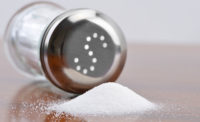Tech | Ingredients
Reducing Sodium to Appeal to More Consumers

Late last year, the Dietary Guidelines for Americans, 2020-2025 — jointly published by the U.S. Departments of Agriculture (USDA) and Health and Human Services — decisively told Americans to limit foods and beverages higher in four areas: sodium, added sugars, saturated fat and alcohol. While the guidelines’ recommended sodium intake levels stayed the same from the report five years ago, for the first time the guidelines highlighted healthy sodium limits for every age group, including infants and toddlers.
The guidelines recommend consumers use the Nutrition Facts label to choose products with less sodium, reduced sodium or no salt added, etc. Reducing sodium in meat and poultry products is top of mind for many processors, but sandwiches, poultry, meat, poultry-and-seafood mixed dishes, deli and cured products remain top sources of sodium intake in the U.S. population.
Sodium’s use as an ingredient in meat and poultry products is not surprising due to its multiple functions, including curing, moisture retention, antimicrobial and flavor enhancement. Instead of reformulating meat and poultry products, Jeff Sindelar, professor and meat extension specialist at the University of Wisconsin in Madison, sees more companies introducing new products with lower or reduced sodium.
Edward Mills, associate professor of meat science at Pennsylvania State University’s College of Agricultural Sciences, in University Park, says the industry has worked for decades on reducing sodium content in processed meat products. For example, cured ham many years ago was commonly 3.5 percent to 3.75 percent salt. Now, as consumers’ tastebuds have become more sensitive to salt, cured ham is about 2.25 percent salt as an industry standard, Mills says.
“If we tweak the salt content down a little bit and we don’t get any pushback from our consumers in terms of flavor performance of the product, then we stay there,” Mills says.
Additionally, consumers currently get a general sense in the press that they consume more salt than needed, which leads consumers to search for products with lower salt contents, he adds.
Reducing Sodium
Sodium chloride is difficult to reduce in meat and poultry products because of its use for flavor, binding, texture and water-holding capacity.
If a processor wants to make a reduced-sodium claim on the label, such as reducing the amount by 25 percent, a sodium replacement must be used in order to keep the functional properties of water bonding capability and protein solubilization along with cooking performance and texture at a similar level, Mills says. Potassium chloride would be an obvious substitute in terms of ionic strength and the protein functionality, but potassium introduces a new flavor note.
“You can’t put much in until you have something that consumers pick up and resist,” Mills explains.
With respect to flavor, processors also can take the direction of boosting up other seasoning and spices when they are reducing salt considerably.
“You change the balance of the flavor a bit, but you aren’t left with this empty-mouth feeling that comes from having a real low-salt product,” Mills explains.
Label Considerations
While processors immediately think about flavor when sodium levels are reduced, sodium’s functional properties are critical and vary from product to product. For example, an injection-marinated fresh product uses salt to help meat proteins bind water. Processors have options of formulating with a hydrocolloid, starch material or some other ingredient from the plant realm with good water-binding capability. For example, hydrocolloids such as carrageenan are effective at low concentrations in boosting water binding. Of course, processors still have to consider how these ingredients look on a product label.
“The hydrocolloids, many of those have names that just don’t roll off the tongue as something you’re familiar with,” Mills says.
Salt’s antimicrobial function is another consideration. “We’ve already reduced salt in processed meat products a great degree from a time when salt was really important for microbial stability of products,” Mills explains. “The reality is, even with refrigeration, the shelf life of products is favored by higher salt concentrations.”
Processors may consider improved microbiological processes, improved sanitation and microbial controls in a plant along with adding antimicrobial ingredients.
Moving forward, Sindelar expects processors will continue to work on reducing sodium as opportunities arise, but an industrywide effort to really move the bar on sodium as it has done in the past is not expected. He says processors are always looking for opportunities to make their products more attractive to a larger demographic of consumers though. NP
Looking for a reprint of this article?
From high-res PDFs to custom plaques, order your copy today!









